Life and Learning in the Garden: An Interview with Homeschooling Homesteader Kallie Vaughn
“I wonder how we actually thought that we would try to be farmers,” she laughed, thinking back to when it all started. Today, my friend Kallie Vaughn and her husband Matt are resurrecting an old farm on 25 acres in the rolling hills of the North Carolina Piedmont. Matt teaches high school, and Kallie homeschools their six children, ages 4 to 15. In this interview, Kallie shares how her whole family is learning important lessons in the garden and all around The Homeplace Farm.
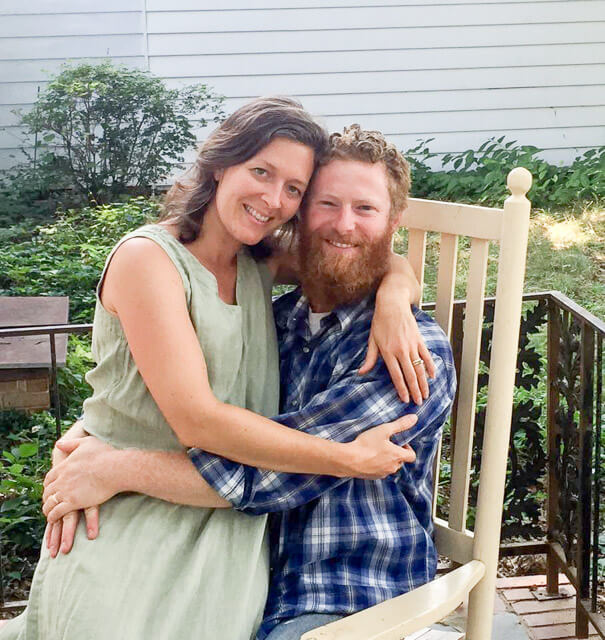
An incredible chain of life events, including Matt’s leg being broken in two places, a new career in teaching, and the renovation of an old house, led to their purchase of the farm land. Kallie can trace the chain’s start to the moment she chose the seat next to a cute boy in cowboy boots in a college poetry class. She and Matt have shared a deep friendship and love of poetry ever since. Along the way, they lived in 12 different places over 15 years. In each place they called home, they created some kind of small garden.
Kallie and I went to high school together. Long-time readers might remember my interview with our fellow classmate, permaculture educator and YouTuber Justin Rhodes. No embarrassing high school photos this time, but here are the two of us after we dug up some mountain mint for Kallie to take home. 🙂
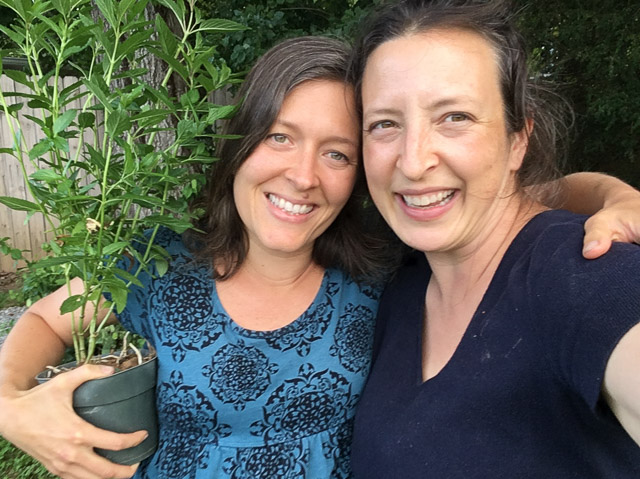
Kallie and I talked for a long time catching up, exchanging stories, and circling back to my interview questions. Here is my interview with her, edited for clarity and length.
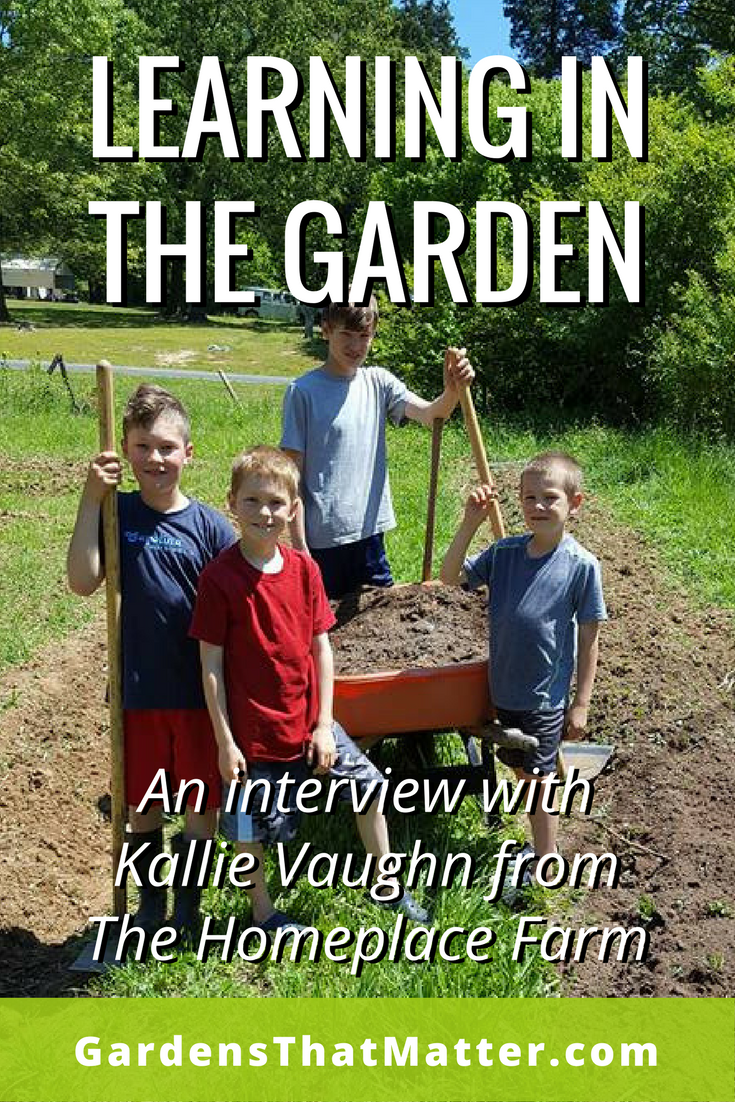
Amy: Tell me more about your journey to growing your own food.
Kallie: I wonder how we actually thought that we would try to be farmers. Matt read Joel Salatin’s You Can Farm way back before we ever even had any thought of being farmers. Then, he’s always loved Wendell Berry. He’s probably his all-time favorite author.
(New to Wendell Berry? The Mad Farmer Liberation Front and The Peace of Wild Things are great places to start reading.)
Then, all along the way, wherever we were—in a crazy apartment or on a farm—we always grew something. It was always in our hearts to grow something. When we renovated our last house, it had a half acre lot. We turned the whole backyard into a garden. That’s what really started us thinking we could do a lot more. And we started to look for land.
And we were spending between $1,000 and $1,500 in food. We had all these boys and I knew they were going to be hungry teenagers some day. I thought, “They’re going to eat us out of house and home.” Did you know that Shakespeare coined that phrase?
I did not. They’re going to eat us out of house and home?
Yes. I’ve been quoting Shakespeare my whole life…
…and didn’t even know it!
Yeah! I was like, we have to have a way to feed them as they get older. They eat so much fruit. And I wanted vegetables and eggs and meat, and I wanted to do it all.
[When we had the opportunity to buy the farm,] I really had a homesteading vision of just providing everything for ourselves as much as we could.
The first thing that we did was a small orchard. I knew that it would take at least five years for it to have a decent yield. We have ten trees. Pears and apples, and then we have blueberries and a fig.
We started some grapes and we have blackberries on our property, but they’re wild so they’re thorny. I’d like to do more with berries. Blueberries do well where we live, so we want to increase the blueberries. Each kid could probably eat a whole entire plant or two.
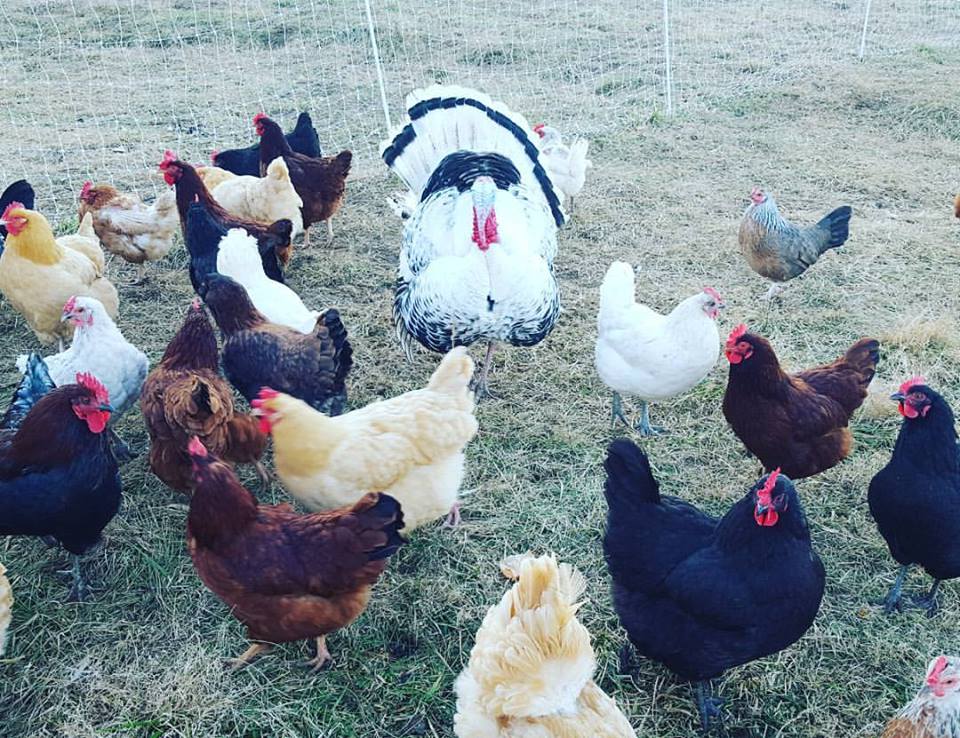
Chickens (and a turkey!) at the Homeplace. Photo: Kallie Vaughn.
Our chickens were the second thing that we did. We do a lot of paleo meals, so we eat a dozen and a half eggs every morning for breakfast. That’s not including eggs for any other meal. So possibly, two dozen eggs a day just for our own family.
Two dozen eggs a day is a LOT of eggs!
Yes, we needed the eggs and then we decided to do the meat birds on pasture in a chicken tractor. We move them all over the place behind the cows.
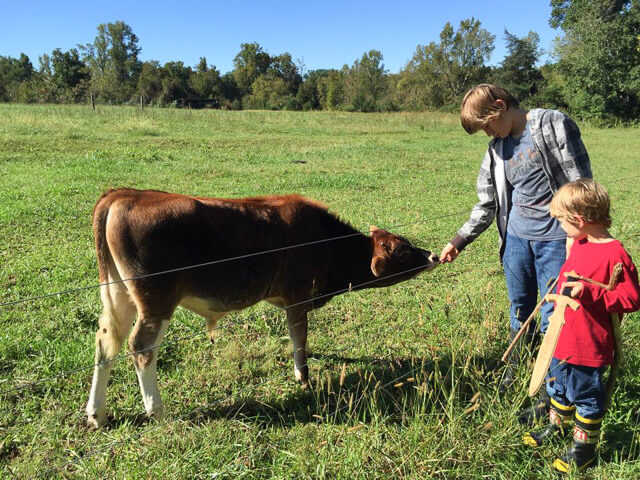
For the cows, Matt uses mob grazing. He doesn’t let them have free range over the pasture because they’ll just eat their favorite things and that’s not really good for a pasture. He moves the cows through the pasture and moves the chickens behind them to spread the poop out. We’ve seen our pasture improving.
That’s exciting!
It is, and resurrecting it all has been really exciting because we can see these old parts as we’re peeling back the layers.
I’m really thankful that we didn’t jump in too fast. I’ve seen where some people jump in too fast and get burned out.
We still have the vision for Matt to come home [from teaching]. We have that hope in our minds, but we don’t know when that will happen.
Our goal is just to be self sustainable. The second goal, income, if we can.
Those sound like great goals, and you’ve definitely hit on my next question. What is your “why” for growing food?
Well, there are two reasons. The practical is just to feed ourselves because it’s expensive to go to the store and I know that we can do it better.
Why do we garden? My question back would be: Why go to the store if you can grow it yourself?
You know that nothing has been sprayed on it, and especially for your children’s sake. You know that you’re providing the best possible food.
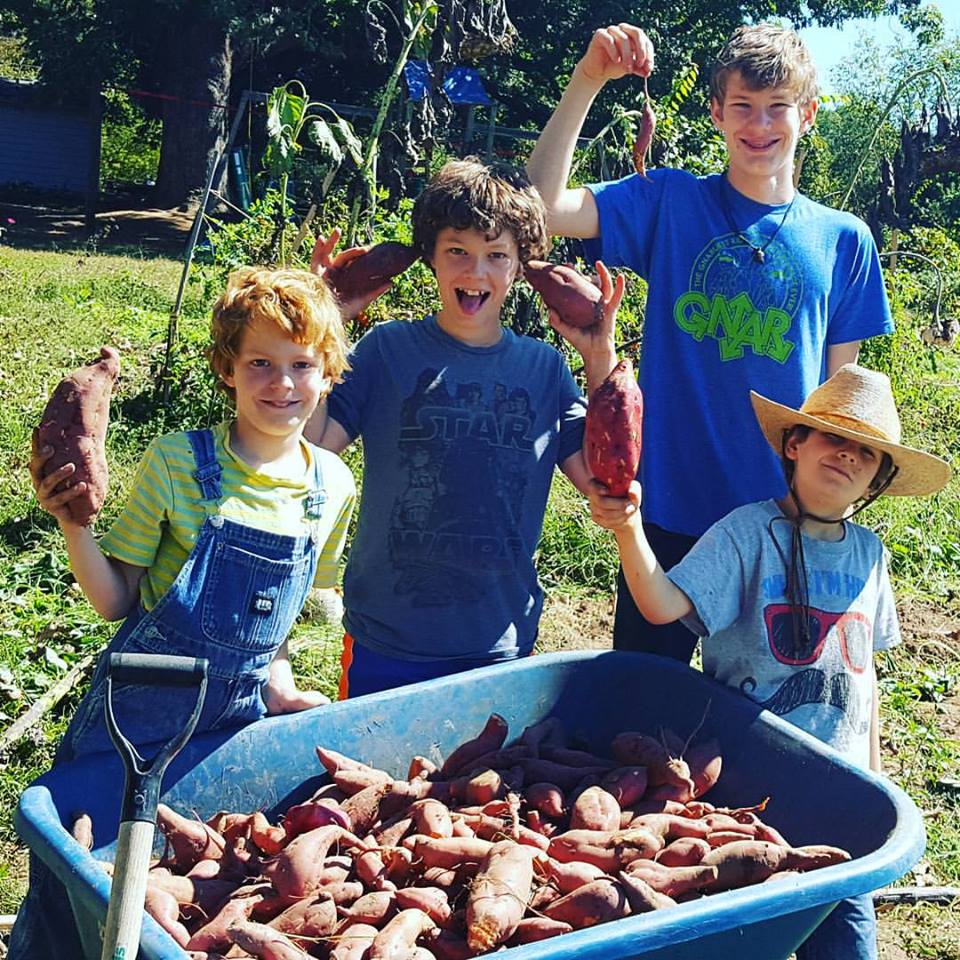
Sweet potato harvest! Photo: The Homeplace Farm
The philosophical reasons… I think that inside of us, every person has some need to be a part of creation. Maybe not everyone wants to be a farmer, but we have a sense that we want to take part in creation and make something. There is an element of wanting to be a part of something bigger.
Nature, to me, is the thing that keeps me connected.
We live in such a disconnected world with our technology. I can see a lot of good in it, but at the same time, it disconnects us from people and from the land.
To reconnect with something that’s alive and meaningful is practical and also fills this deep need that we have within ourselves. Be creative and be part of creation.
Being a part of creation, putting a seed in the ground…a seed! A seed to me is mind blowing. A seed doesn’t look like anything. And then you just put it in the dirt, which also doesn’t look like anything. It just looks like dirt, and then amazing things happen.
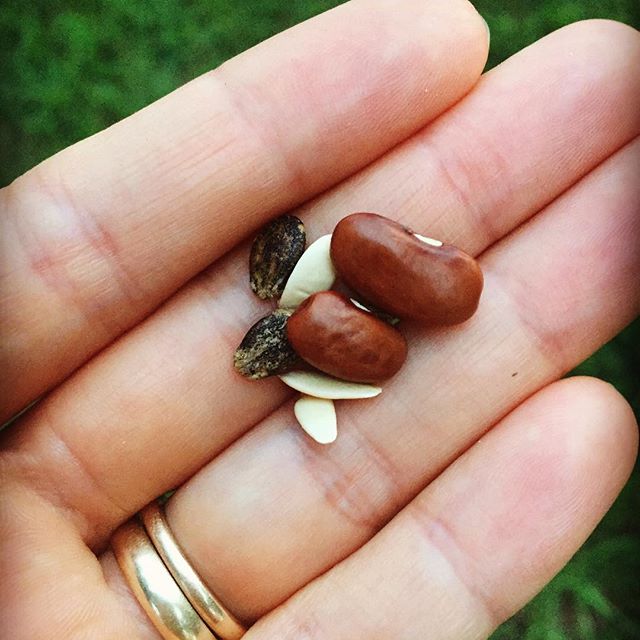
Seeds ready for planting. Photo: The Homeplace Farm
It’s just like babies when they’re growing inside the womb. There’s something beautiful happening in the darkness. When it comes forth, it’s just beautiful. Seeds always amaze me. I love seeds.
Me too! You mentioned that your garden is on contour. Does that mean you have swales and berms? Will you describe your garden setup for me a little more?
The swales are the walking paths (when they’re not filled up with water). Then, there are mounded-up beds. It looks like curvy rows.
We keep adding cow manure mixed in with leaves and things from whenever Matt mows. It all mixes together. And the lady before us had goats. Her old goat pasture is where we have found this rich, black almost, soil. We’ve dug that up, and spread it all over.
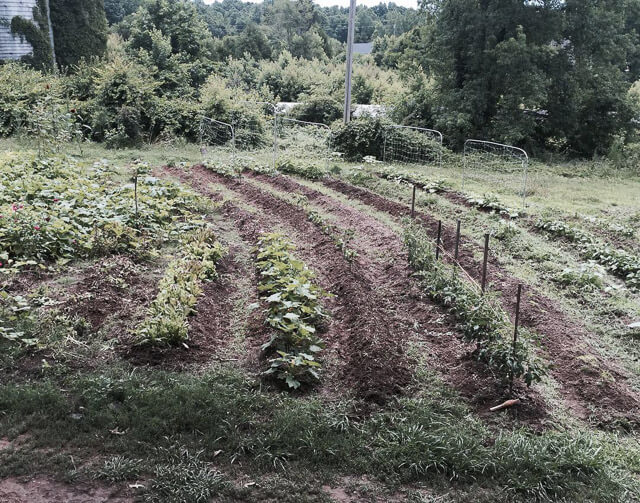
Raised rows on contour create swales and berms. Photo: The Homeplace Farm
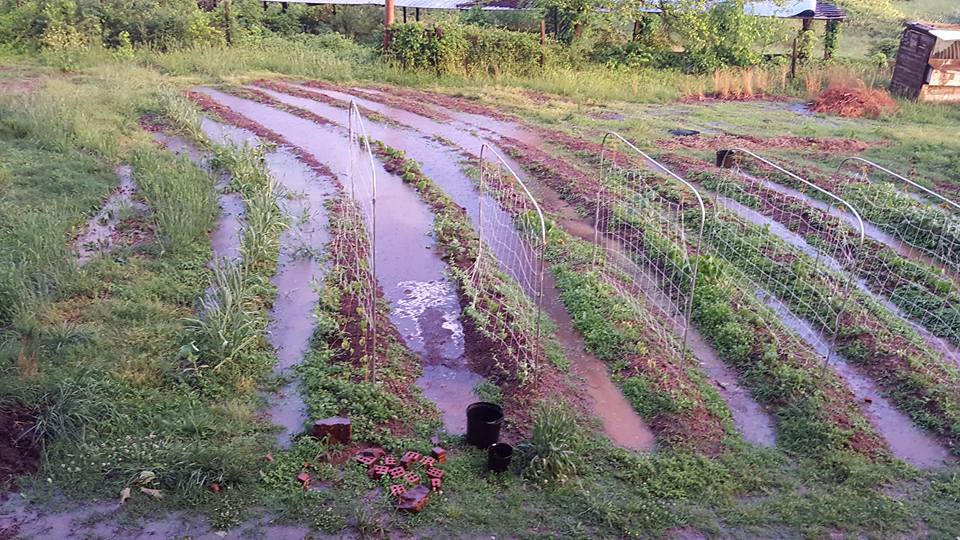
Rain captured by the garden swales seeps into the soil. Photo: The Homeplace Farm
Kallie described how Charlotte Mason’s approach to education has influenced their homeschool and garden:
We don’t separate our life from our school from our garden. It all is a learning experience.
“Education is an Atmosphere, a Discipline, and a Life.” Those are the three principles of Charlotte Mason’s philosophy.
Atmosphere is our thought life and the ideas that direct our life so we don’t want to create an atmosphere that work is burdensome. I think with gardening, because it is such hard work at times, how we view work shapes and has an impact on the children’s attitudes.
It’s really important whenever we’re doing backbreaking stuff (and this is kind of Wendell Berry-ish, too), we don’t think of separating our time into work and leisure. We want to think of work as a joyous thing. Something that we can take part in together.
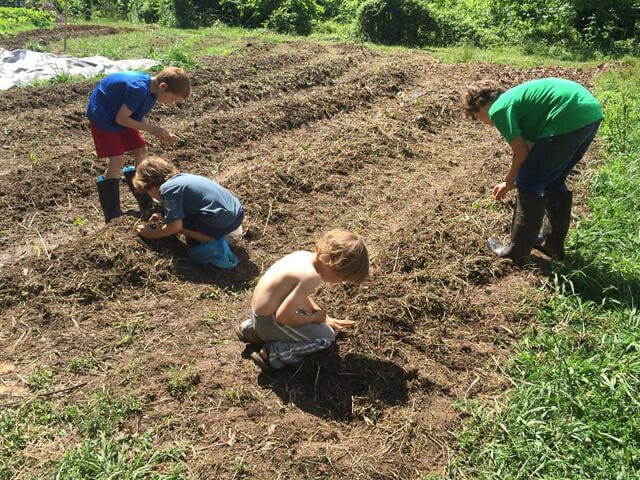
Planting seeds. Photo: The Homeplace Farm
It’s a family culture. This is meaningful and this is something joyful that we can do together. There’s no rush. It doesn’t have to be perfect. This is all about learning and creating.
It sounds like you’re intentional about modeling that.
It is very hard, parenthood is refining.
All of a sudden you have such a great responsibility to be this model. As my husband always says, our actions prove what we really believe. It is so true and our kids are watching our every move.
Do you garden as part of your daily routine?
Yes. Normally, we would do school in the morning, but in the summertime, we need to do anything outside before ten because it’s so hot. So, we do gardening first then school during the hot time then the pool. That’s going to be the incentive.
We don’t say, “If you really help, we’re going to go to the pool.” Or, “If you really help, we’re going to give you ice cream.” We don’t verbalize it; we just put it into action. If we have a long work day in the garden, I might buy them ice cream or we do something fun together like jump in the creek.
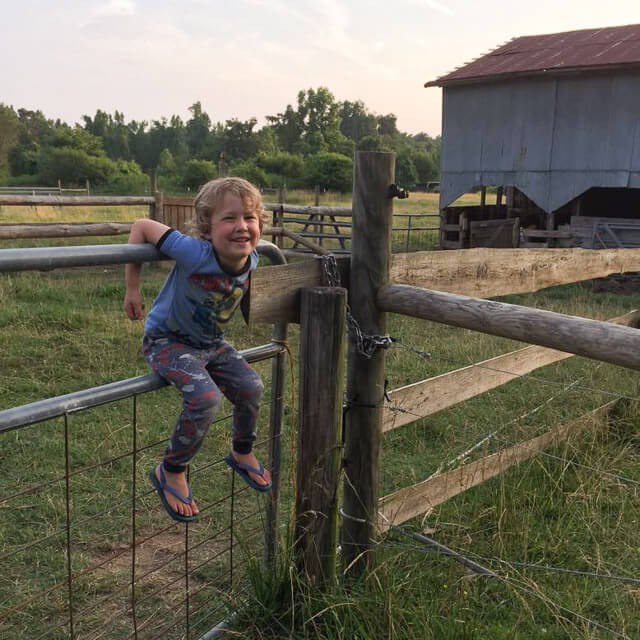
Kallie told me more how Mason’s second principle of discipline fits into gardening and learning in the garden:
What I tell my kids is “short bursts” and now my sons say it, too. Do your best work for a short amount of time. Kids can sustain a high level attention and hard work in these short bursts, and they can be really successful that way.
I always think about that time in the garden as, “Let’s go on our morning walk through the garden together and see.” I’ll point things out, “That’s a squash bug and that’s not a good bug to have in the garden…Oh, look at all those lady bugs. That’s really good…Look at all these worms. We want them here.”
It’s a conversational style walking through the garden and being in relationship with them in that space. It makes it not such drudgery. You don’t want it to be drudgery.
Just walk through your garden and see what needs to be done. And, I’m building up the idea of what the harvest will be like and how we’ll be able to eat all the food. It’s motivating.
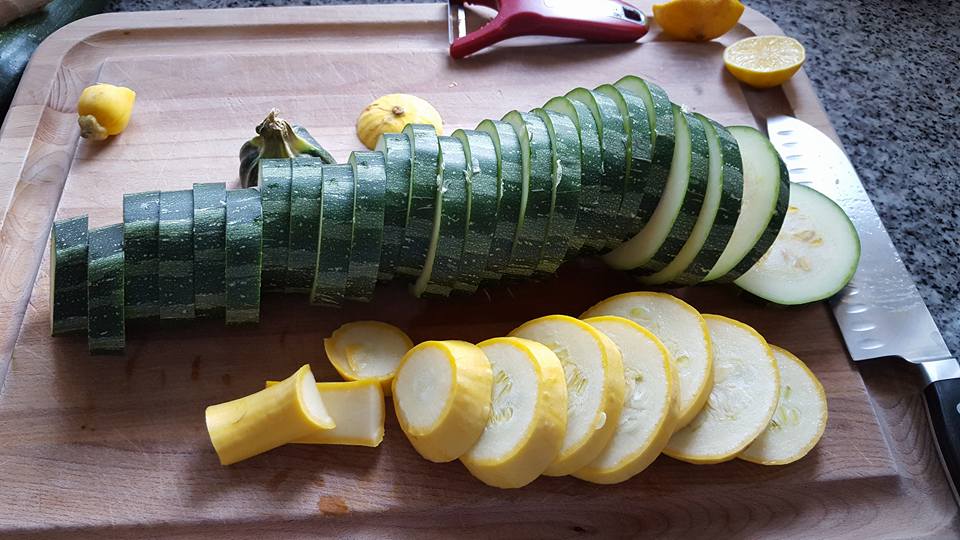
Squash and zucchini harvest! Photo: The Homeplace Farm
Consistency is the other thing. Discipline on a consistent basis.
Short bursts and daily twice a day. 10 minutes in the morning. 10 minutes in the afternoon. Just taking a short walk.
We always say, “We don’t have time.” But it’s just building a consistent habit.
The other thing that always goes through my mind is my great-grandmother used to sing, “He walks with me and he talks with me,” like walking in the garden with God. I have that hymn in my mind a lot of times, and sing it. Songs…singing really lifts our spirits.
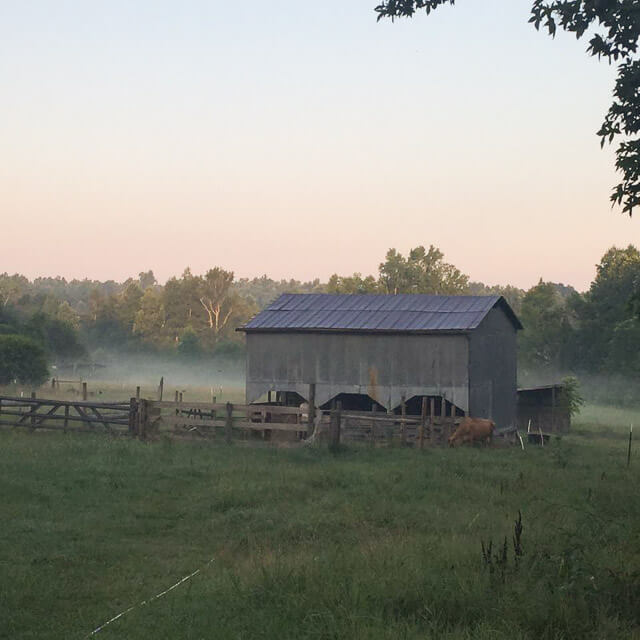
So back to the idea of education as “an atmosphere, a discipline, and a life.” The life is the relationships. I just love the picture of that loving relationship…and walking and talking in the garden.
For us farming is about food but it is even more about family and togetherness.
Can you tell us about a success you’ve had in growing food with kids?
We let them each have their own section. That was probably our greatest success.
We let them plan and plant and tend a row of their own. Giving them total responsibility—they took off with it. They’ve loved it.
Instead of us saying, “Come help us in the garden,” we were saying, “Go take care of your part of the garden.”
They picked out what they wanted to plant, and then we helped them. If they needed trellises, they helped us build them. They were in charge of planting the seeds, harvesting, weeding. Everything.
And we know who is actually taking care of their part by walking through. “Hey, wait a minute! You have like 500 beans that need to be harvested.”
The four year old even has his own section, and we help him and our six year old as they need us. A lot of people don’t think kids at a young age are capable, but they really are if they think you believe in them. If they know you have confidence that they can do, then they do. They rise up to your expectations.
The kids said their favorite part was planting the seeds. I thought they would say harvesting. Whenever we have a harvest, any kind of harvest, we make a huge deal about it. We talk about how delicious it is and how much better it tastes than the store to really get it in their hearts. The fruit of our labor is more delicious whenever we’ve worked hard for it…it is so satisfying.
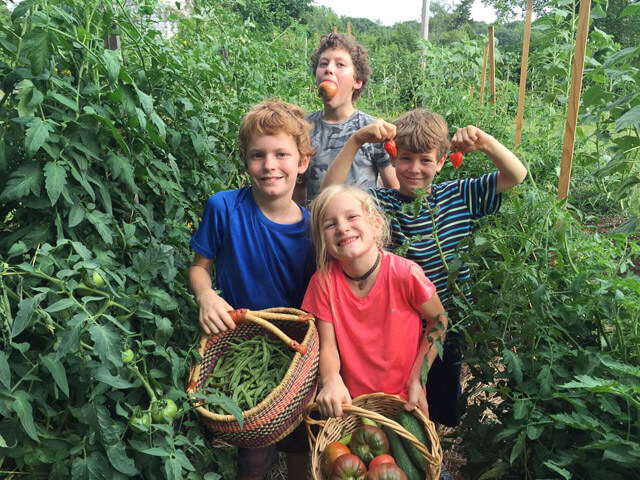
Harvest time! Photo: The Homeplace Farm
Matt would say the greatest success is observing the sense of wonder the kids have about growing food…from putting seeds in the ground, to seeing the first seedlings pop up, to finding the first sign of fruit, to harvesting. They are excited each step of the way and their excitement never ceases…so in that way they are teaching us!
I would also say that perseverance pays off. We have made many mistakes along the way and had plenty of failures…but all of that is part of learning. I am so thankful we didn’t give up and I count our perseverance as a huge success!
Can you take me in the other direction? What is your biggest challenge in gardening and farming with kids?
Our biggest challenge has been bugs because we don’t spray. We have been overrun, and I’m not kidding. Squash bugs and borers totally devoured and demolished. Last year, we had Mexican bean beetles on our beans.
We’ve done all kinds of murderous things. Every day, we all go out there and we’re just killing, pinching them. We drown them—we get a bucket and drop them in.
As far as challenges with kids, the biggest one is to loosen up and expect participation, but not perfection. We want to be careful to gently teach them in the garden and not criticize their efforts.
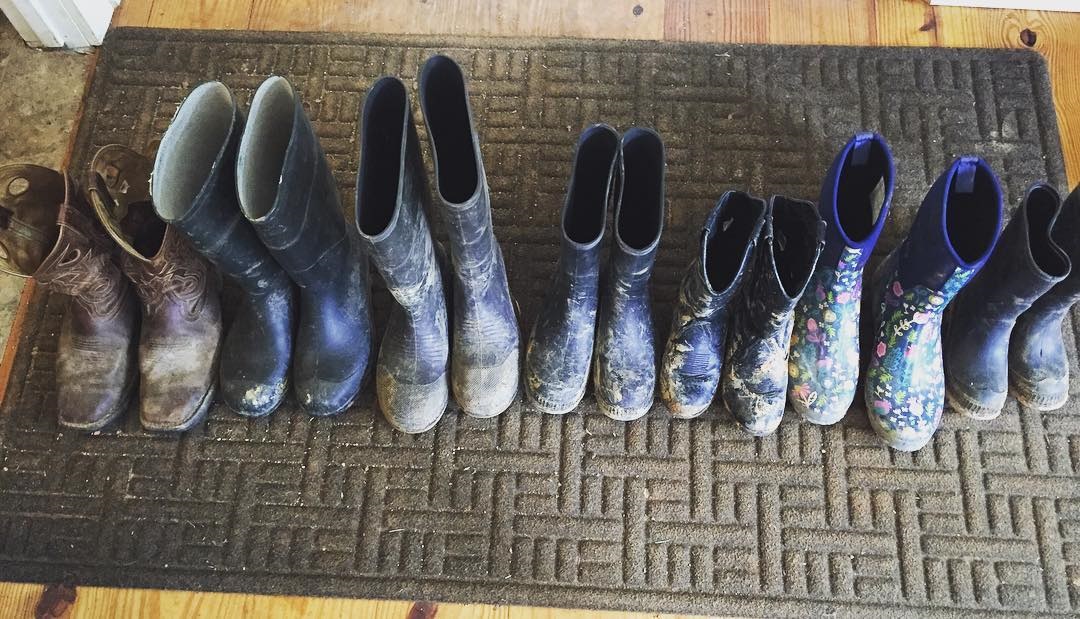
Boots for feet of all sizes at the Vaughn’s house. Photo: The Homeplace Farm
Let’s get specific. What are your kids’ favorite plants? And what are yours and Matt’s?
Several of them said tomatoes and most of them said cucumbers. My kids love pickles with a passion. One of my sons made a whole pickle garden because he wanted to eat pickles every day.
Then I have this one kid that loves any kind of vegetable. He’s my best vegetable eater, and he’ll eat anything. We actually came up with a decoy garden idea because we discovered we couldn’t have a successful harvest [with him in the garden eating].
My littlest one said, “Pumpkins.” And I just love pumpkins. They make me feel cozy. I love fall, and I love seeing pumpkins.
Last Thanksgiving, my neighbor drove to my house with a truck bed full of all kinds of pumpkins. Decorative little pumpkins and giant pumpkins. Every color and size. I was like, “Oh, my gosh. This is happiest day of my life.”
It was perfect because we were having 60 people for Thanksgiving, and I wanted to do a centerpiece on each table. I was able to do all these pumpkins, and it was such a happy moment.
I also love flowers and herbs. I have an inherited love of zinnias, which has been from my great-grandmother to my grandmother to my mother, and to me. We all love zinnias.
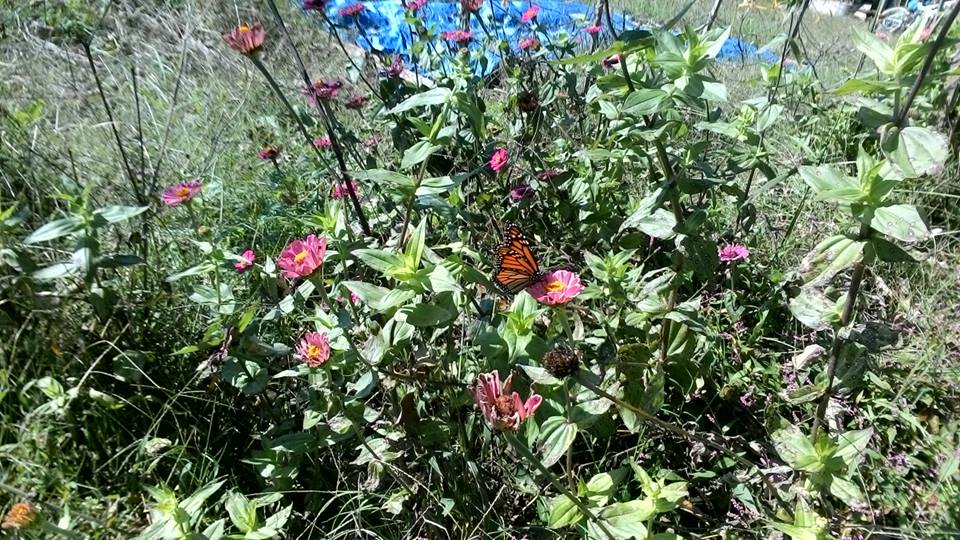
A monarch drinks nectar from a zinnia. Photo: The Homeplace Farm
Matt said he doesn’t have a favorite thing to grow. He likes everything, but when I forced him to narrow it down, he said lettuce and kale.
If you woke up one morning and you had to start your garden all over again, what would you do first and what would you plant first?
We would start small so that the garden doesn’t become overwhelming, because that can rob the joy out of it. We actually really liked doing raised bed gardening.
The first thing I would plant are perennial herbs, something that would come back every year without much effort. Our oregano and thyme are the ones that we use almost every day.
A good starting place is something practical that you would use, whatever flavors you like. You could just walk out there and grab a little bit, and put it in your food.
Matt would plant annuals. They are fun because you get to see the whole life cycle of the plant. That is definitely cool, too.
And we both agreed that it is a good idea to put effort into planning the garden. We’ve paid the price for a lack of planning in the past!
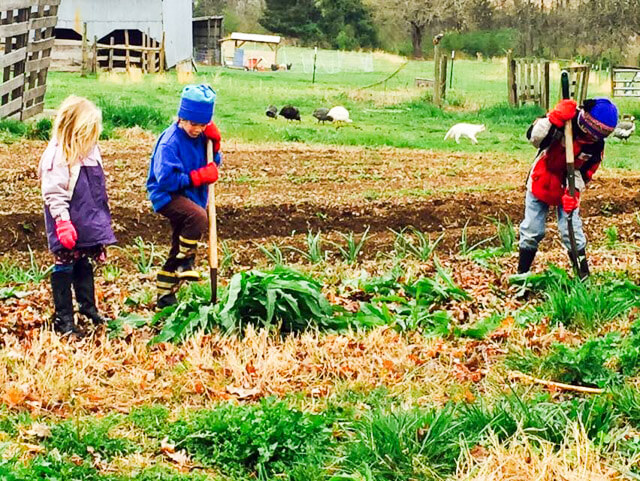
Before we go, tell me a little more about the future of your farm.
In the immediate future we are going to expand pastured broiler production and we are on the cusp of having continual beef and dairy production with our third generation of calves born this year.
But we aren’t just producing food, we’re trying to produce a sense of place. Working together is a central component of that vision that binds the generations and roots us all on the land.
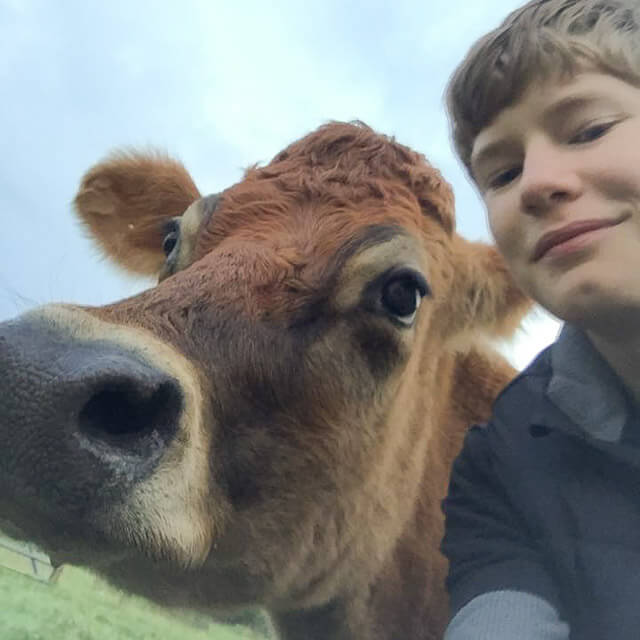
Photo: The Homeplace Farm
So the bigger kid version of [why gardening and farming with kids matters] is learning stewardship, responsibility, and hard work.
We have a multi-generational vision for our farm, but we don’t put the pressure on our children.
That’s one reason why we named it The Homeplace Farm. My mom grew up in Kentucky, they had an old family home place. Hopefully, our farm will be our children’s home place…
That your kids will come back to…
and the grandchildren and the great-grandchildren. That’s the hope!
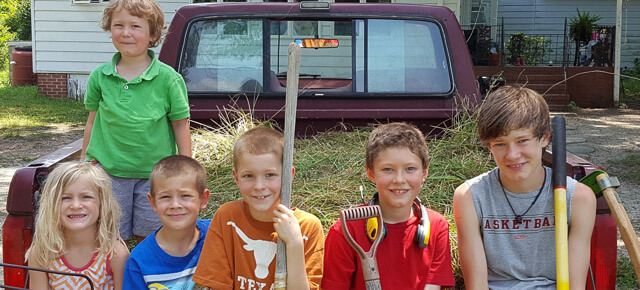
The start of a multi-generational dream. Photo: The Homeplace Farm
Now, we’d love to hear from you!
Kallie and I would love to hear about how you and your family are learning and living in the garden? What about Kallie’s approach and their farm really resonated with you? Tell us in the comments below.
You can also connect with Kallie and Matt on Facebook and Instagram.
Want to read more “mama gardener” interviews? (Daddy gardeners, too!) Click here to subscribe.

Beautiful article! As Kallie’s mother it makes my heart happy to be at the farm with her and her family. It takes me back to my childhood. I love that they live each day in gratitude and my GRANDS are living in an “unplugged” world.
Beautiful article ! Had to repeat that . So proud of Kallie and Matt . Teaching the kids such basic things as Gardening is so good for the Soul , and to know that they will pass it on for generation’s . Please know . I know how hard the work is , but to make it a Family active . can be fun , and the memories are lasting . Really enjoyed reading this article .
I love the article. I read every word. I taught with Dianne at Estes and loved to hear her tell about the adventures of this family. Thanks for sharing.
Diane – Kallie is amazing! I so enjoyed talking to her about their family and farm, and I love what they’re doing, too. You should definitely be a proud mom and grandmother! 🙂
Thanks, Debbie! They are definitely an inspiration. I love the point you make about how their will pass it on for generations. 🙂
I’m so glad you enjoyed reading it, Loveta!